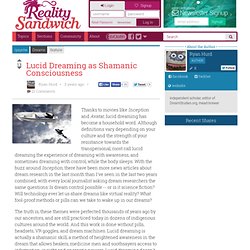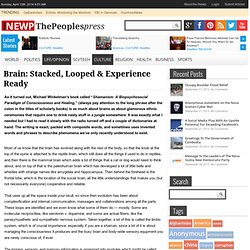

Shamanic Trance States. In order to journey to the other dimensions of existence a Shaman induces an altered state of consciousness in himself similar to a state of self-hypnosis called a state of flow.

While in this state of flow, or Shamanic Trance, he is in complete control. He is able to take his consciousness and subtle bodies into nonphysical reality where he visits the heavens and hells of existence, communicates with and controls spirits, gains information, retrieves souls, and makes subtle changes in reality which may affect the physical world.
Properties of the Shamanic altered state of consciousness are: There is a sense of egolessness. It is as if a person feels as if they are merging with people and objects around them. As if they are in a single state of consciousness. In a state of flow, you feel as if you have actually become one with the activity you are focused on. That is to say, NOT "a look and feel," but actually taking place. Joseph Bearwalker Wilson. Dennis Mckenna - Shamanism, Consciousness, and the future of Psychedelics. Lucid Dreaming as Shamanic Consciousness. Thanks to movies like Inception and Avatar, lucid dreaming has become a household word.

Although definitions vary depending on your culture and the strength of your resistance towards the transpersonal, most call lucid dreaming the experience of dreaming with awareness, and sometimes dreaming with control, while the body sleeps. With the buzz around Inception, there have been more news articles about dream research in the last month than I've seen in the last two years combined, with every local journalist asking dream researchers the same questions: Is dream control possible -- or is it science fiction? Will technology ever let us share dreams like virtual reality? What fool-proof methods or pills can we take to wake up in our dreams? The truth is, these themes were perfected thousands of years ago by our ancestors, and are still practiced today in dozens of indigenous cultures around the world.
Conquistadors of Consciousness Beyond the Wilderness of Dreams Dream Control. Kelley Harrell: Shamanism: Religion or Neurology? In his recently released book, Shamanism -- a Biopsychosocial Paradigm of Consciousness and Healing, Michael Winkelman sheds interesting light on the question of the true basis of shamanism.

Much of the research on shamanism gifted us from the academic community has straddled the fence between the esoteric and the scientific. A common position on what we call traditional shamanism -- ancient and indigenous tribes with exclusive cultural rituals and cosmology -- is that it is a religion. The more scientific avenue of neuropsychology offers the idea that some people with the right brain chemistry and the right cues happen to tap into shamanic states. From what Winkelman suggests, none of this is accurate. Not only is shamanism not a religion (defined as a set of beliefs comprising why we're here, how we got here, the deities who preserve us here, our rituals by which we thank them and a moral code that keeps us all in line), it's also not set aside for a select few.
Brain: Stacked, Looped & Experience Ready. As it turned out, Michael Winkelman’s book called “Shamanism: A Biopsychosocial Paradigm of Consciousness and Healing,” (always pay attention to the long phrase after the colon in the titles of scholarly books) is as much about brains as about glamorous ethnic ceremonies that require one to drink nasty stuff in a jungle somewhere.

It was exactly what I needed but I had to read it slowly with the radio turned off and a couple of dictionaries at hand. The writing is exact, packed with composite words, and sometimes uses invented words and phrases to describe phenomena we’ve only recently understood to exist. That uses up all the space inside your skull, so since then evolution has been about complexification and internal communication, messages and collaborations among all the parts. These loops are identified and we even know what some of them do — mostly. People can be seriously deformed by physical trauma as in the head injuries of the football game our country loves so much.